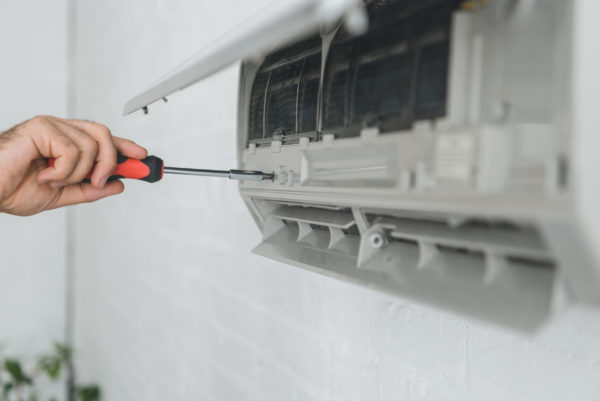How Ductless Air Conditioners Work

All About How Ductless Air Conditioners Work
When it comes to keeping your home cool over the summer, the common approaches are central air conditioners and window unit air conditioners. Discover how the increasingly popular ductless air conditioner works and the benefits it’ll bring compared to the traditional options.
Major Parts of an Air Conditioner
Both central air and ductless air conditioners share the same primary components. There is the indoor unit that contains the evaporator coil. This is where the refrigerant gets cold enough to absorb the heat from the air inside.
Then, there’s the outside condensing unit. This contains the condensing coil and the air conditioning compressor. It’s the outside unit that vents the heat absorbed from inside your home to the air outside.
Finally, there’s the control unit for the air conditioner. A central air conditioner uses a thermostat to control the unit. A ductless system uses an on-board thermostat combined with a remote control. If you get an advanced system, you may have a control app for your smartphone.
The Difference Between Central Air and Ductless AC
If both systems operate by absorbing heat from inside your home and transferring it outside, how do they differ? It comes down to how the system circulates air to properly cool your home.
A central air system has one air handling unit that connects to a series of ducts that go to vents throughout your home. As the system runs, the air pushes from the air handling unit, through the ducts, and out into your home. It also has one or more return registers that draw air into your HVAC system.
A ductless system operates without ducts. Rather, the air handling unit commonly mounts to a wall inside your living space. The air handling unit draws air in, cools it down, and then immediately pushes it back out.
Smaller air handlers won’t circulate as much air as a central air handling system. Air volume is measured in cubic feet per minute, or CFM. The largest limiter for ductless systems is the amount of air it circulates in any given space.
Mini-Split vs. Multi-Split Air Conditioning
Within the ductless systems, you have the option of a mini-split versus a multi-split system. A mini-split uses a single air handler with a single condenser outside. These systems are commonly good for cooling a single room or space.
A multi-split air conditioner uses multiple air handlers with a single condensing unit. You install the air handlers throughout your home for these systems, creating zones to tightly control the temperature.
Do I Need Multiple Indoor Units?
As you consider the use of a ductless system, you’ll need to calculate the capacity and how many air handlers you’ll need. Air conditioners measure capacity in British Thermal Units, or BTUs. For ductless air conditioners, there’s a question of the capacity of the condensing unit plus the capacity of the air handler.
Each air handler has a limited cooling capacity, which is a function of how much heat the refrigerant can absorb and the volume of air it circulates. Even if the unit can absorb a lot of heat, this ability doesn’t matter if the handler can’t circulate enough air. The system can only absorb heat from the air circulating through, so less air means less cooling.
This is why you may need multiple air handlers to effectively cool your home. You’ll want one in each of the different living spaces in your home. Depending on the size of your bedrooms and their configuration, you may need one to serve them, too. A single condensing unit may work with up to eight different air handling units.
Installation Options
The common ductless air conditioner installs on a wall to your home. This unit can seem a little intrusive since it stands out from the wall. However, if you want to upgrade your system, there are other installation options that may fit your home a little better, but they may be a little more cumbersome to install.
You can install a suspended ceiling unit, or a flush unit, if you have a drop ceiling. There’s also a floor-standing unit available. These other options are more common in commercial spaces than in residential although they may be a good option for some homes.
Is Ductless AC More Expensive?
Most homes in Missouri already have ducts installed for their heating systems. This means that, a ductless air conditioner will cost more than a central air conditioner. With a central system, you’ll tie into the air handler you already have with your furnace, so you’re left with installing the condensing unit, the refrigerant lines, and the evaporator coil.
Your cost will vary depending on the size of ductless system you need and how many air handlers you’re installing. In general, expect to pay $5,000-$8,000 per zone. If you’re installing more than two zones, you’re looking at $11,000 or more to install the system. For a whole-house ductless system, expect the cost to run $20,000 or more.
Benefits of Ductless Air Conditioning
There are many benefits to consider when exploring a ductless air conditioner. First, ductless systems are much easier to install if you don’t have a ducted system to tie into. Rather than burying refrigerant lines and having to run them through the interior of your home, they’ll install through a small hole in the side of your home on the wall where your air handler is located.
Ductless systems are more efficient than central air systems. A significant part of this efficiency comes from the lack of ducts. You lose about 30% of your energy in central air systems through the ducts.
The other efficiency improvement comes from the zones that come with a multi-split system. These only run the air handler in those areas that need cooling, saving the energy from the areas that don’t need it at the time.
Disadvantages of Ductless AC
The biggest disadvantage of a ductless air conditioner is the cost to install, especially if you’re replacing a ducted system. You will save some money on your monthly cooling expenses, but it may not be enough to recoup the difference. Where ductless makes sense from a cost perspective is if you’re installing new ducts or replacing those already in your home.
Ductless systems are more visible than are the traditional central air systems. This can be a hindrance in a space that you’re concerned with the ambiance.
You’ll also have more maintenance on a ductless system. The filter needs cleaning every month to prevent strain from airflow restrictions. If you use a multi-split system, you’ll need routine maintenance on each of the air handlers. You’ll also have more devices that can break down, potentially increasing repair expenses over the life of the system.
Call the Professionals!
When people around O’Fallon want air conditioning service they can trust, they call Hoff Heating & AC. For nearly 40 years, our award-winning team provides both heating and air conditioning installation, maintenance, and repairs combined with indoor air quality solutions. Call to schedule your air conditioning service with one of our expert technicians today!

 Call Us Today
Call Us Today
